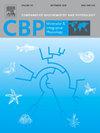Skeletal muscle preservation in arctic ground squirrels during hibernation season
IF 2.2
3区 生物学
Q4 BIOCHEMISTRY & MOLECULAR BIOLOGY
Comparative Biochemistry and Physiology A-Molecular & Integrative Physiology
Pub Date : 2025-03-21
DOI:10.1016/j.cbpa.2025.111847
引用次数: 0
Abstract
Reduced skeletal loading and inactivity leads to muscle atrophy in humans and most mammals. By contrast, hibernating mammals demonstrate limited loss of skeletal muscle mass and strength by the end of winter after being physically inactive for several months. The present study objective was to detect any signs of muscle atrophy and restoration in arctic ground squirrel (AGS) skeletal muscles during the hibernation season. Quadriceps muscles of juvenile AGS males were collected 1–2 weeks before hibernation, and at 2, 6, 10–12 and 16–22 weeks after onset of hibernation during interbout arousal when body temperature returns to euthermic level. Muscle mass, fiber cross-sectional area (CSA) and fiber type composition were determined, as well as total and ribosomal RNA content, and expression of key genes involved in protein degradation. We found that muscle mass, CSA and fiber size distribution were not different between the groups (P > 0.05). No difference was detected in myofiber composition between the hibernation groups compared to pre-hibernation. Total RNA and ribosomal RNA content were not significantly different between the groups during hibernation. Transcript levels of ubiquitin E3-ligase FBXO32 (Atrogin-1, MAFbx) and autophagy related genes MAP1LC3A and BECN1 were not different between the hibernation and pre-hibernation groups. However, ubiquitin E3-ligase TRIM63 (MuRF-1) was significantly higher expressed at 2 weeks of hibernation compared to the other timepoints. These results, for the first time, show that AGS preserve muscles during hibernation season.

北极地松鼠冬眠季节骨骼肌的保存。
骨骼负荷减少和不活动导致人类和大多数哺乳动物肌肉萎缩。相比之下,冬眠的哺乳动物在几个月不运动后,在冬季结束时骨骼肌质量和力量的损失有限。本研究的目的是检测北极地鼠(AGS)骨骼肌在冬眠季节肌肉萎缩和恢复的任何迹象。在冬眠前1-2 周,以及冬眠后2、6、10-12和16-22 周,当体温恢复到恒温水平时,在间歇唤醒时采集雄性AGS幼崽的股四头肌。测定肌肉质量、纤维横截面积(CSA)和纤维类型组成、总RNA和核糖体RNA含量以及参与蛋白质降解的关键基因的表达。我们发现肌肉质量、CSA和纤维大小分布在各组之间没有差异(P > 0.05)。与冬眠前相比,冬眠组之间的肌纤维成分没有发现差异。冬眠期间各组间总RNA和核糖体RNA含量无显著差异。泛素e3连接酶FBXO32 (Atrogin-1, MAFBX)和自噬相关基因MAP1LC3A和BECN1的转录水平在冬眠组和冬眠前组之间没有差异。然而,在冬眠2 周时,泛素e3连接酶TRIM63 (MURF-1)的表达量明显高于其他时间点。这些结果首次表明,AGS在冬眠季节保存肌肉。
本文章由计算机程序翻译,如有差异,请以英文原文为准。
求助全文
约1分钟内获得全文
求助全文
来源期刊
CiteScore
5.00
自引率
4.30%
发文量
155
审稿时长
3 months
期刊介绍:
Part A: Molecular & Integrative Physiology of Comparative Biochemistry and Physiology. This journal covers molecular, cellular, integrative, and ecological physiology. Topics include bioenergetics, circulation, development, excretion, ion regulation, endocrinology, neurobiology, nutrition, respiration, and thermal biology. Study on regulatory mechanisms at any level of organization such as signal transduction and cellular interaction and control of behavior are also published.

 求助内容:
求助内容: 应助结果提醒方式:
应助结果提醒方式:


